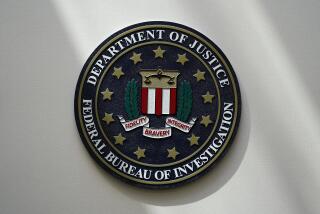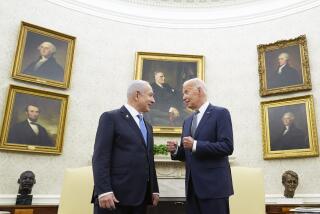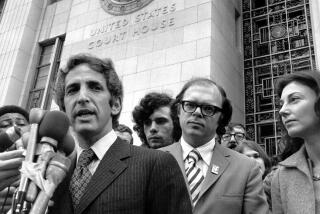In Keeping Its Secrets, CIA Hides Nation’s Past
WASHINGTON — After many years, the American public finally got a rare glimpse at a long-suppressed document about one of the Central Intelligence Agency’s first major clandestine efforts to overthrow a sitting government. For decades, historians have been pressing the CIA to declassify its report on the 1953 U.S.-sponsored coup in Iran, but the agency stubbornly refused, leaving it to journalists and leakers to do the job.
The 1953 coup against Prime Minister Mohammed Mossadegh was a turning point in U.S.-Iran relations--and in Middle Eastern history. By helping to overthrow the still-popular nationalist leader, Washington succeeded in buttressing the repressive rule of Shah Mohammed Reza Pahlavi for another quarter-century. Many Iranians today point to August 1953 as the genesis of the virulent anti-Americanism that exploded with the revolution of 1979 and the subsequent hostage-taking and still characterizes official Iranian policy toward the United States.
The CIA’s internal accounts of the coup remain one of the last hopes for more fully understanding what took place. The decision to keep withholding them after 47 years seems absurd, given that at least three of the key U.S. and British agents have published memoir accounts, and scholars have interviewed almost all the agents involved.
The recently leaked but still officially secret “clandestine services history,” written in early 1954, reveals several important facts. For example, the CIA’s concerns about the shah’s cravenness ran so deeply that the agency was apparently ready to stage the coup without him. Local Iranians, including important members of the clergy, played a critical role in the operation’s success, often acting under direction of the CIA. And the British had a far more substantial part in planning and financing the operation than previously suspected.
Yet, even though the New York Times recently printed a lengthy article based on the leaked material--and, more important, posted several appendixes to the report on its Web site--there is still far more to the story. For one thing, the paper chose not to publish the main body of the 200-page report on the grounds that Iranians named in it who are still living in Iran might face reprisals. Though the newspaper provided a lengthy description of the document by journalistic standards, it is still a secondhand account with much valuable information withheld. Moreover, two of the key appendixes posted are merely plans that include some measures apparently never taken, lessening their value for understanding what really happened. Hopefully, a judicious solution to the dilemma over the names will be found, and the essential parts of the main history will be posted on the Web.
Certainly, there is much to be learned from the parts of the document not yet seen. What exactly was the nature and extent of the role of the clerics? How far-reaching were CIA contacts within the government, the military or the parliament, whose members the agency apparently expected to “purchase”? How much were these individuals motivated by genuine political reasons versus the generous financial incentives the CIA offered?
These kinds of facts would provide a far better basis for judging such fundamental questions as how “spontaneous” the uprising actually was and how well the agency or the British were able to understand and penetrate Iranian society.
More broadly, since the CIA has touted Operation TP-Ajax as one of its first major covert successes, we might get a clearer picture of how the U.S. government handled similar operations from Indonesia to Tibet to the Congo, information not available to the American public. What was it in this report, for instance, that made its author, Donald N. Wilber, write at a later date, “If this history had been read by the planners of the Bay of Pigs, there would have been no such operation”?
The larger problem, and the reason leaks of secret document are often used to fill the empty pages of U.S. history, is that the CIA has persistently refused to part with all but a small fraction of its files on the Iran coup, and most of its other well-known covert actions. After the end of the Cold War, three successive CIA directors promised to review these records, but in 1998 the current director, George J. Tenet, citing a lack of resources, reneged on those pledges.
Last year, the National Security Archive finally took the agency to court under the Freedom of Information Act. Among other things, the suit asks for the two internal histories of the ’53 coup that are known to exist. One is the document just leaked. The other, prepared more recently by the CIA historian’s office, is important because it presumably offers a different perspective on the coup and can be used to check for accuracy and the possibility of bias in the earlier analysis, which Wilber, one of the operation’s chief planners, wrote just months after the fact.
Unfortunately, the lead information officer for the CIA’s operations division has continued to balk, swearing under oath last August that declassifying these materials “could reasonably be expected to cause serious damage to the national security.” Out of a total of 339 pages at issue, the CIA has released only one sentence--”Headquarters spent a day featured by depression and despair”--and that only because it had already appeared in Wilber’s memoir.
Clearly, the recent revelations show how disingenuous the CIA’s claims are. No harm will befall the republic because of this leak, just as none has come from the CIA’s own, and far more extensive, declassification of the 1961 Bay of Pigs and 1954 Guatemala operations.
Predictably, the CIA’s recalcitrance has now backfired. By refusing to strike a reasonable balance between protecting information that is truly sensitive and the public’s right to a full accounting of its government’s actions, the agency has only lowered its credibility and that of the entire classification process. The fact that a former official with access to the document chose to leak it is a sign of how decrepit the system has become.
Finally, by acquiescing to the agency’s obstinacy, the Clinton administration may have let a symbolic opportunity for improving ties with Iran slip away. After almost a half-century of mythologizing on the part of many Iranians about CIA omnipotence and U.S. animosity, it will not be easy to shift those perceptions. But a decision to open the approximately 1,000 pages of classified records on the coup that have survived destruction all these years would be a welcome gesture in the spirit of opening the “dialogue of civilizations” both countries’ presidents have endorsed. *
More to Read
Sign up for Essential California
The most important California stories and recommendations in your inbox every morning.
You may occasionally receive promotional content from the Los Angeles Times.










